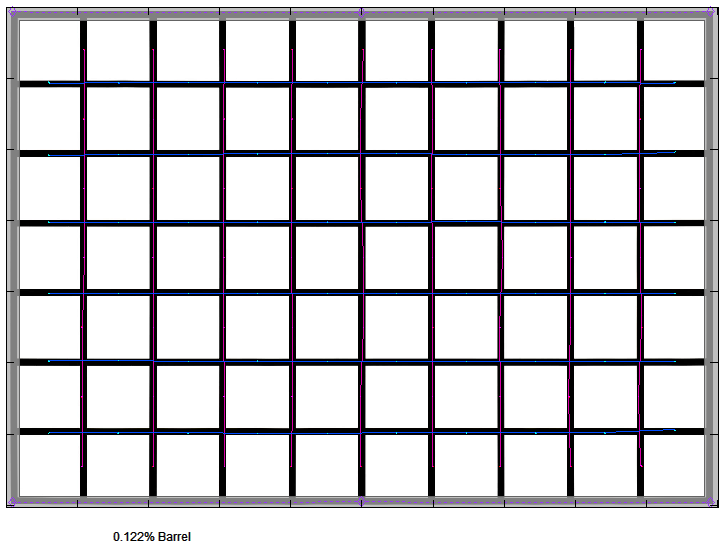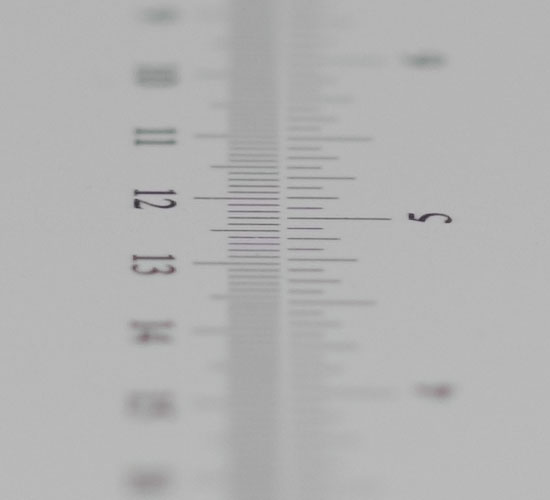|
Fujinon XF 56mm f/1.2 R APD ( Fujifilm ) - Review / Test Report - Analysis |
|
Lens Reviews -
Fujifilm X
|
|
Page 2 of 3

Distortion
The produced distortion of the Fujinon is marginal at just ~0.1%. This applies both to auto-corrected images as well as uncorrected RAW files.

Vignetting
The light falloff is a different story. In RAW mode the vignetting is heavy with a peak of ~1.4EV (f-stops) at f/1.2. The issue is already much improved at f/2 and essentially irrelevant from f/2.8 onward. In auto-corrected JPEG mode, the camera digitally corrects the vignetting down to 0.8EV at max. aperture and 0.6EV at f/1.6. Interestingly it is fairly obvious that the camera "presses the brake" at these settings because the figures are identical with the RAW variant from f/2.8 onward. It's quite interesting to note that vignetting is the sole characteristic where the APD lens behaves differently to the non-APD in one of the "formal" categories.
Please note that vignetting compensation is lossy - it comes at the cost of higher sensor noise in the image corners due to the required "amplification".

MTF (resolution)
As mentioned the optical design has been inherited from the Fujinon XF 56mm f/1.2 R so other than sample variations and an impact from the apodization filter, the results should be and are very similar. Thus at f/1.2 it is capable of delivering a very good center performance combined with good albeit not stellar borders/corners. Stopping down improves the quality slowly but steadily till reaching a peak quality around f/5.6. The center quality is excellent followed by very good to excellent borders/corners. Diffraction effects have a slight impact at f/8. As usual, you should avoid smaller apertures than f/11.
The centering quality of the tested sample was good. The field curvature is low.
Please note that the MTF results are not directly comparable across the different systems!
Below is a simplified summary of the formal findings. The chart shows line widths
per picture height (LW/PH) which can be taken as a measure for sharpness.
If you want to know more about the MTF50 figures you may check out the corresponding
Imatest Explanations

Chromatic Aberrations (CAs)
The lateral CAs (color shadows at hard contrast transitions) are already quite low with an average pixel width of ~0.6px at the image borders at f/1.2. The issue is reduced down to around 0.1px at and beyond f/2.8 - this is absolutely negligible.

Bokeh
The key feature of the Fujinon XF 56mm f/1.2 R APD is the rendering of out-of-focus areas. Now does it deliver? Well, mostly at least.
The general out-of-focus blur is very smooth and buttery especially in front of the focus point but also beyond. The lens is superior to the non-APD variant here although it still isn't perfect.
 Unfortunately, out-of-focus highlights aren't quite as impressive. While you can spot the effect of the APD filter, the Fujinon inherits the weakness of its non-APD cousin here - it can show outlining effects at very large apertures here. They can be reduced by stopping down and they aren't really an issue anymore from f/2 onward.
Unfortunately, out-of-focus highlights aren't quite as impressive. While you can spot the effect of the APD filter, the Fujinon inherits the weakness of its non-APD cousin here - it can show outlining effects at very large apertures here. They can be reduced by stopping down and they aren't really an issue anymore from f/2 onward.

Bokeh Fringing
Bokeh fringing is an axial color fringing effect. It can show up as purple halos in front of the focus point and greenish halos in the background. Just like most of the ultra-large aperture lenses the Fujinon is also affected although, surprisingly, not quite as pronounced as on its non-APD counterpart.
|
Move the mouse cursor over the f-stop marks below to observe the respective LoCAs
|
| f/1.2 |
f/1.6 |
f/2 |
f/2.8 |
f/4 |
|

|
|